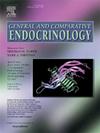Post-lactation mass recovery and metabolic hormone dynamics in adult female Weddell seals
IF 1.7
3区 医学
Q3 ENDOCRINOLOGY & METABOLISM
引用次数: 0
Abstract
Weddell seal (Leptonychotes weddellii) females lose substantial body mass across an intensive, nutritionally restricted lactation period and then must rapidly recover mass during the short Antarctic summer. In this study, we examined endocrine dynamics associated with mass loss across lactation and subsequent realimentation in Weddell seals, comparing patterns between seals that recently gave birth and demographically similar non-reproductive females (skip females) in McMurdo Sound, Antarctica. Postpartum seals near weaning (∼35 days postpartum, n = 64) and skip females (n = 32) were handled during early austral summer (November/December) and rehandled in late summer (January/February). Body mass, body composition (% lipid), and a suite of metabolic hormones (growth hormone (GH), insulin-like growth factor (IGF)-I, cortisol, total thyroxine (tT4), free thyroxine (fT4), and total triiodothyronine (tT3) and IGF binding protein (IGFBP)-2 and −3) were measured. Postpartum seals gained mass after weaning (0.98 ± 0.56 kg·day−1 (mean ± SD)), primarily as lean tissue rather than lipid, while their serum concentrations of tT4 and fT4, IGF-I, and cortisol increased. Their circulating GH and IGFBP-2 concentrations decreased and correlated negatively with mass. Skip females had greater body masses and lipid stores than postpartum seals at the end of the lactation period in early summer, but they lost mass (−1.03 ± 0.35 kg·day−1) and lipid stores over summer while their serum cortisol concentrations increased. Overall, body mass and composition of postpartum and skip females converged across summer. This convergence, likely driven in large part by contrasting endocrine profiles between the groups, may allow female Weddell seals to reach an advantageous seasonal body mass “set point” by onset of winter.
成年雌威德尔海豹泌乳后质量恢复和代谢激素动态。
威德尔海豹(Leptonychotes weddellii)雌性在密集的、营养受限的哺乳期会失去大量的体重,然后必须在南极短暂的夏季迅速恢复体重。在这项研究中,我们研究了威德尔海豹在哺乳期间和随后的实现中与质量损失相关的内分泌动力学,比较了南极洲麦克默多湾最近分娩的海豹和人口统计学上相似的非生殖雌性海豹(略过雌性)之间的模式。在南部初夏(11月/ 12月)处理接近断奶的产后海豹(产后~ 35 天,n = 64)和跳跃性雌海豹(n = 32),并在夏末(1月/ 2月)重新处理。测量体重、体成分(%脂质)和一组代谢激素(生长激素(GH)、胰岛素样生长因子(IGF)- 1、皮质醇、总甲状腺素(tT4)、游离甲状腺素(fT4)、总三碘甲状腺原氨酸(tT3)和IGF结合蛋白(IGFBP)-2和-3)。产后海豹在断奶后体重增加(0.98 ± 0.56 kg·day-1(平均 ± SD)),主要是瘦肉组织而不是脂质,同时血清中tT4和fT4、IGF-I和皮质醇浓度升高。循环GH和IGFBP-2浓度下降,且与质量呈负相关。初夏哺乳期结束时,雌跳鸡的体重和脂质储存高于产后海豹,但随着夏末雌跳鸡的血清皮质醇浓度升高,雌跳鸡的体重和脂质储存下降(-1.03 ± 0.35 kg·d -1)。总体而言,产后和跳跃性雌性的体重和组成在整个夏季趋于一致。这种趋同在很大程度上可能是由不同种群之间的内分泌特征差异所驱动的,这可能使雌性威德尔海豹在冬季到来时达到一个有利的季节性体重“设定点”。
本文章由计算机程序翻译,如有差异,请以英文原文为准。
求助全文
约1分钟内获得全文
求助全文
来源期刊

General and comparative endocrinology
医学-内分泌学与代谢
CiteScore
5.60
自引率
7.40%
发文量
120
审稿时长
2 months
期刊介绍:
General and Comparative Endocrinology publishes articles concerned with the many complexities of vertebrate and invertebrate endocrine systems at the sub-molecular, molecular, cellular and organismal levels of analysis.
 求助内容:
求助内容: 应助结果提醒方式:
应助结果提醒方式:


